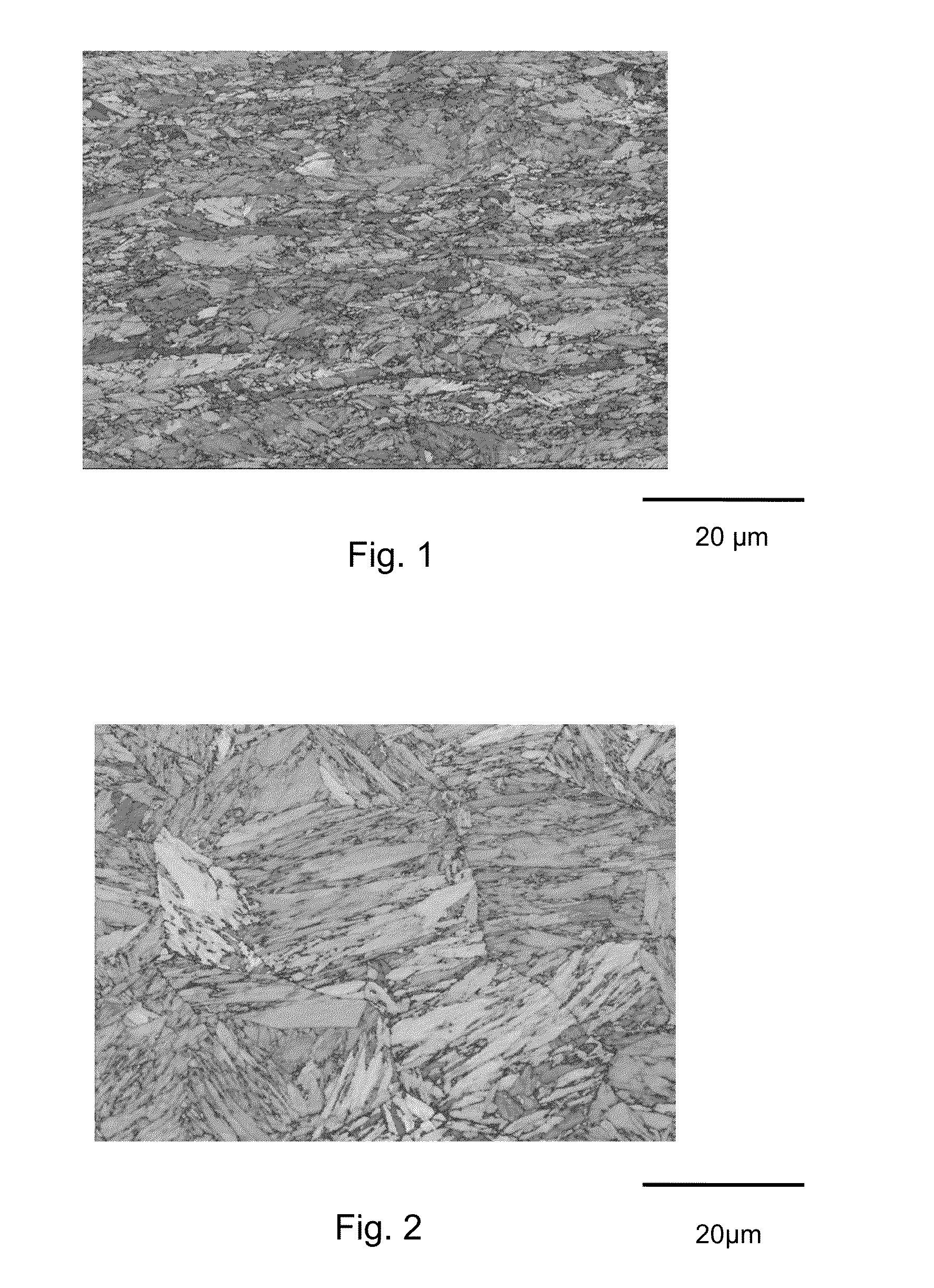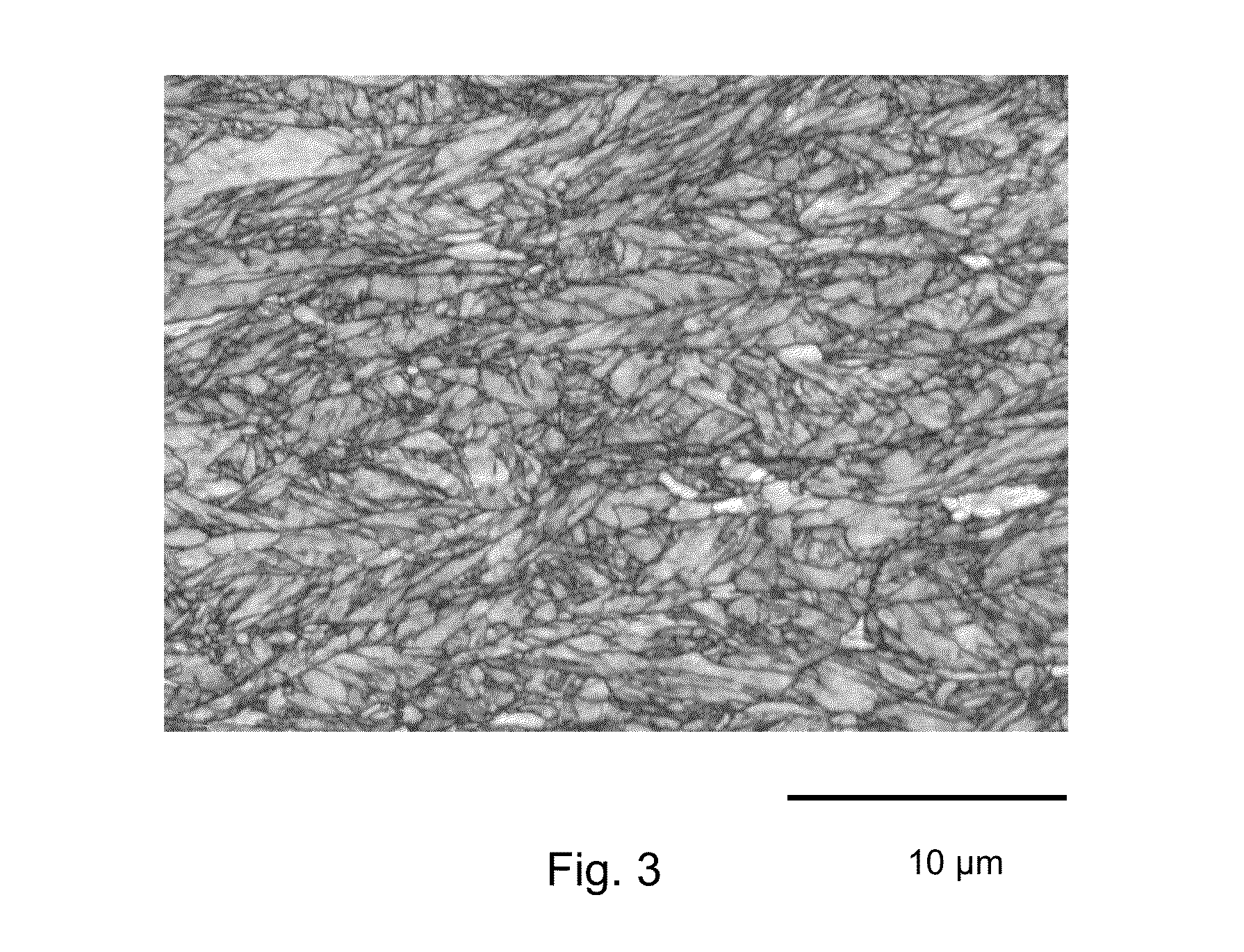Method for the production of very high strength martensitic steel and sheet or part thus obtained
- Summary
- Abstract
- Description
- Claims
- Application Information
AI Technical Summary
Benefits of technology
Problems solved by technology
Method used
Image
Examples
example 1
[0073]Semi-finished steel products are provided containing the elements listed below, expressed in percent (%) by weight:
0.5Mn +SteelCMnSiCrMoAlSPNbTiBCr + 3MoA0.1951.9450.011.9090.050.030.0030.020.010.0120.00143.03B0.241.990.011.860.0080.0270.0030.020.008——2.88
[0074]Semi-finished products 31 mm thick were heated and held for 30 minutes at a temperature T1 of 1050° C., then subjected to a roughing rolling in 5 passes at a temperature T2 of 910° C. to a thickness of 6 mm, i.e. a cumulative reduction rate εa of 164%. At this stage, the structure is totally austenitic and completely recrystallized with an average grain size of 30 micrometers. The sheets thus obtained were then cooled at the rate of 25° C. / s to a temperature T3 of 550° C. at which they were rolled in 5 passes with a cumulative reduction rate εb of 60%, then cooled to ambient temperature at a rate of 80° C. / s to obtain a completely martensitic microstructure. For purposes of comparison, steel sheet having the composition...
example 2
[0084]Steel blanks with a thickness of 3 mm were obtained with the following composition, expressed in percent by weight (%):
0.5Mn +SteelCMnSiCrMoAlSPNbCr + 3MoB0.241.990.011.860.0080.0270.0030.020.0082.88
[0085]The blanks were then subjected to a heating to 1000° C. (i.e. Ac3+210° C. approximately) for 5 minutes. They were then:[0086]either cooled to 50° C. / s to the temperature T3 of 525° C. then hot-stamped at this temperature with an equivalent deformation εc greater than 50%, and then cooled at a rate greater than the critical martensitic quenching rate (test B2)[0087]or cooled to 50° C. / s to the temperature of 525° C., then cooled at a rate greater than the critical martensitic quenching rate (test B3)
[0088]The following table presents the mechanical properties obtained:
Test Temper- ature T3 (° C.) Re (MPa) Rm (MPa) 3220% C + 908 IΔRmI (MPa)Aver- age lath size (μm) lmax_lmin_ Inven-B25251531191216812990.93tionRefer-B3—132016521681291.85enceTest conditions and...
PUM
| Property | Measurement | Unit |
|---|---|---|
| Grain size | aaaaa | aaaaa |
| Grain size | aaaaa | aaaaa |
| Length | aaaaa | aaaaa |
Abstract
Description
Claims
Application Information
 Login to View More
Login to View More - R&D
- Intellectual Property
- Life Sciences
- Materials
- Tech Scout
- Unparalleled Data Quality
- Higher Quality Content
- 60% Fewer Hallucinations
Browse by: Latest US Patents, China's latest patents, Technical Efficacy Thesaurus, Application Domain, Technology Topic, Popular Technical Reports.
© 2025 PatSnap. All rights reserved.Legal|Privacy policy|Modern Slavery Act Transparency Statement|Sitemap|About US| Contact US: help@patsnap.com



